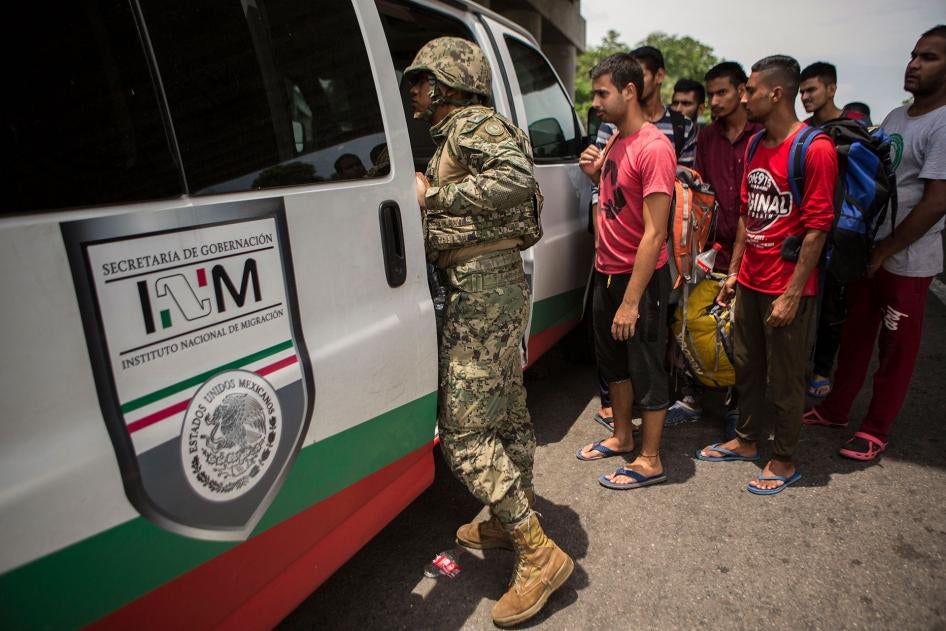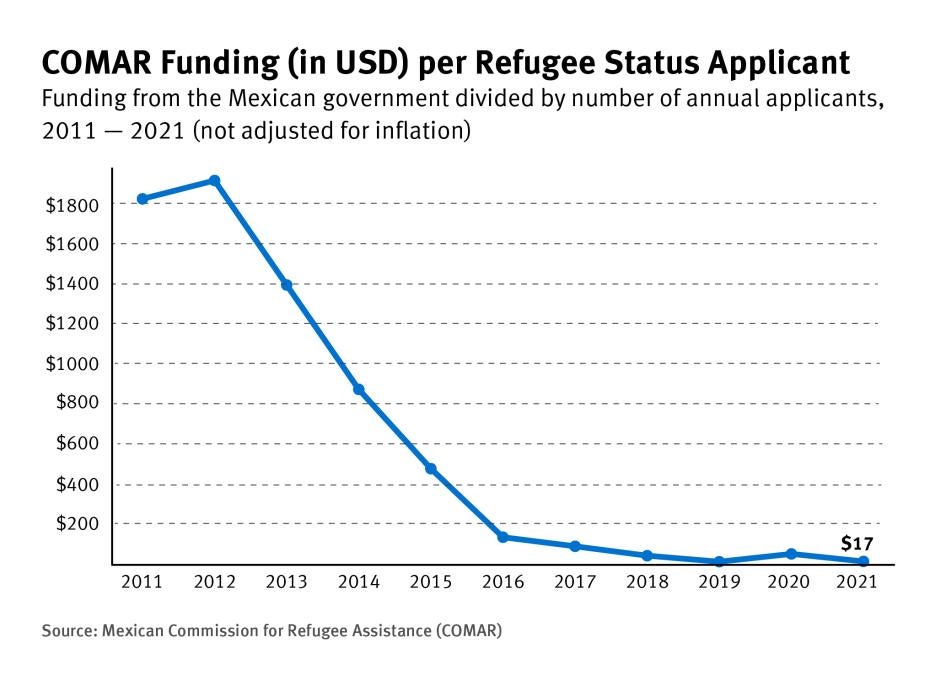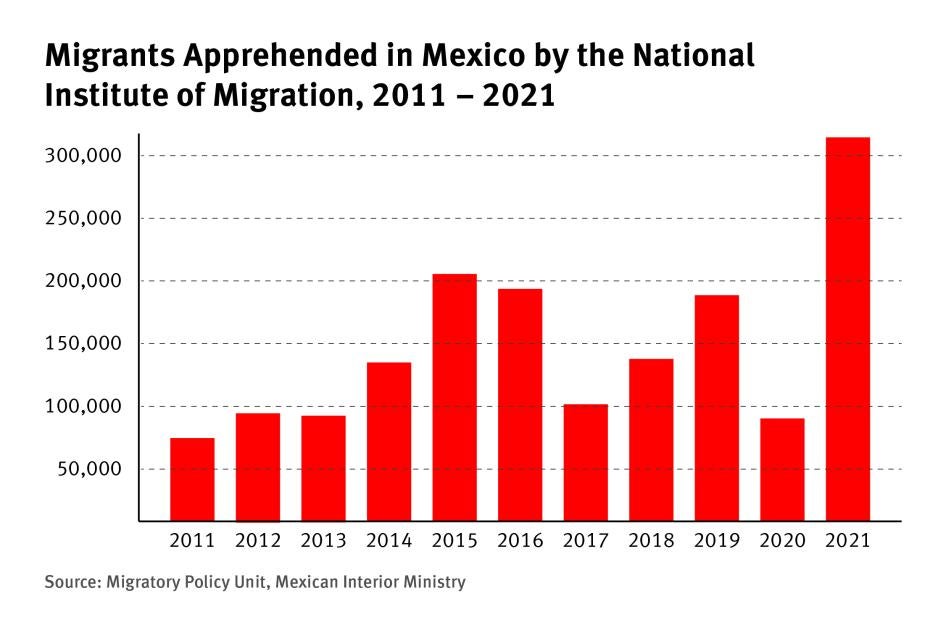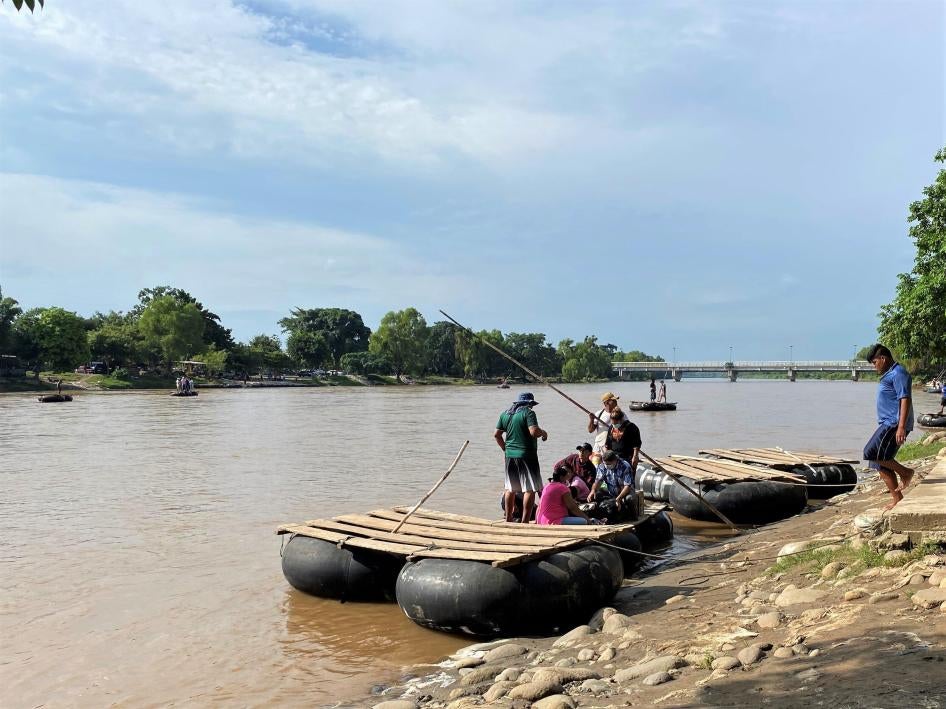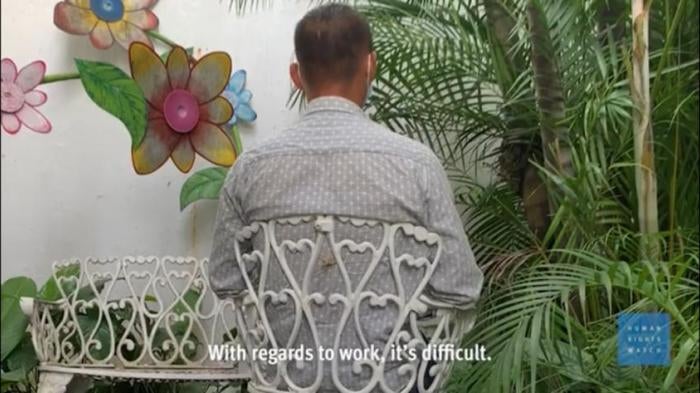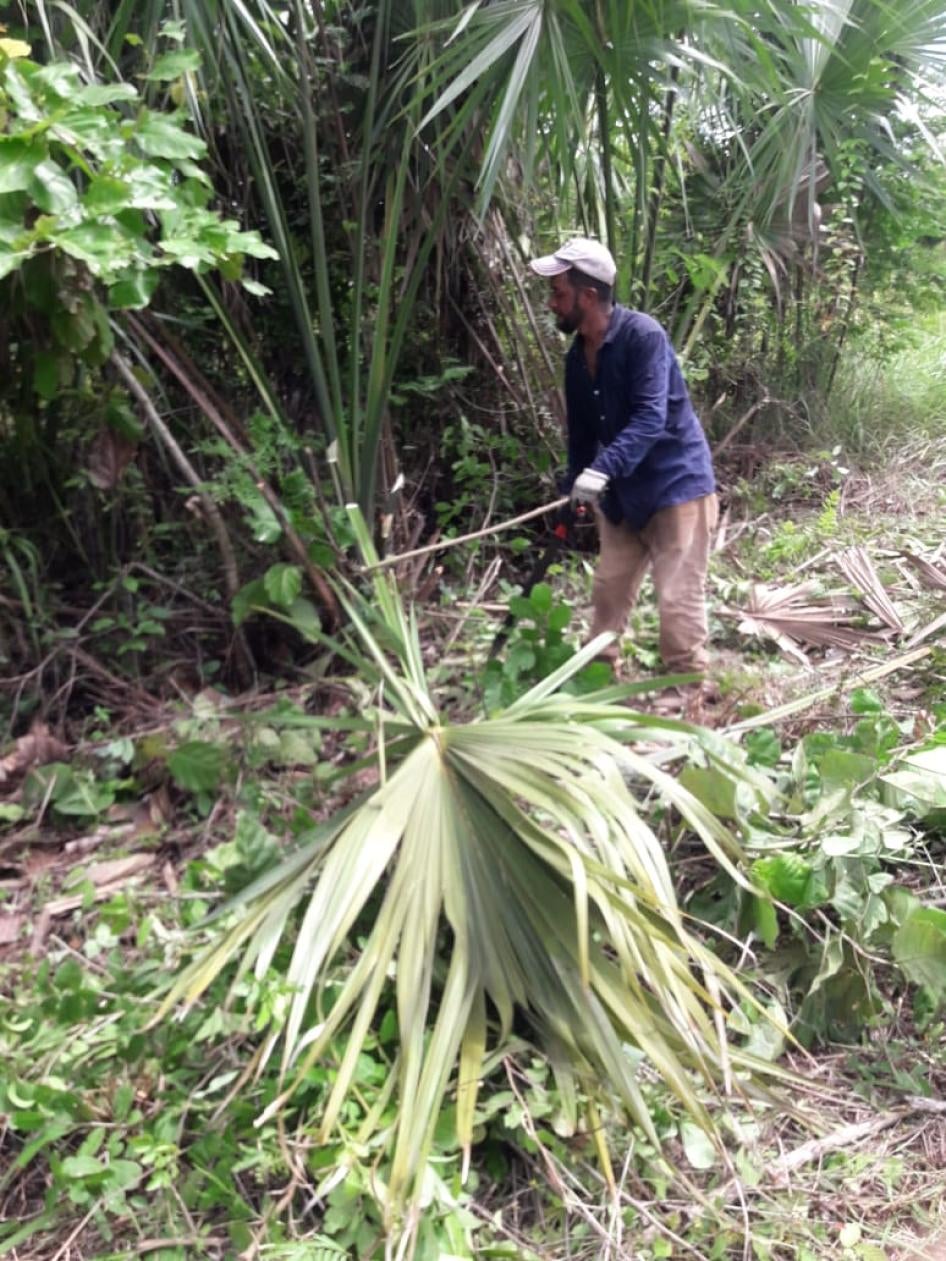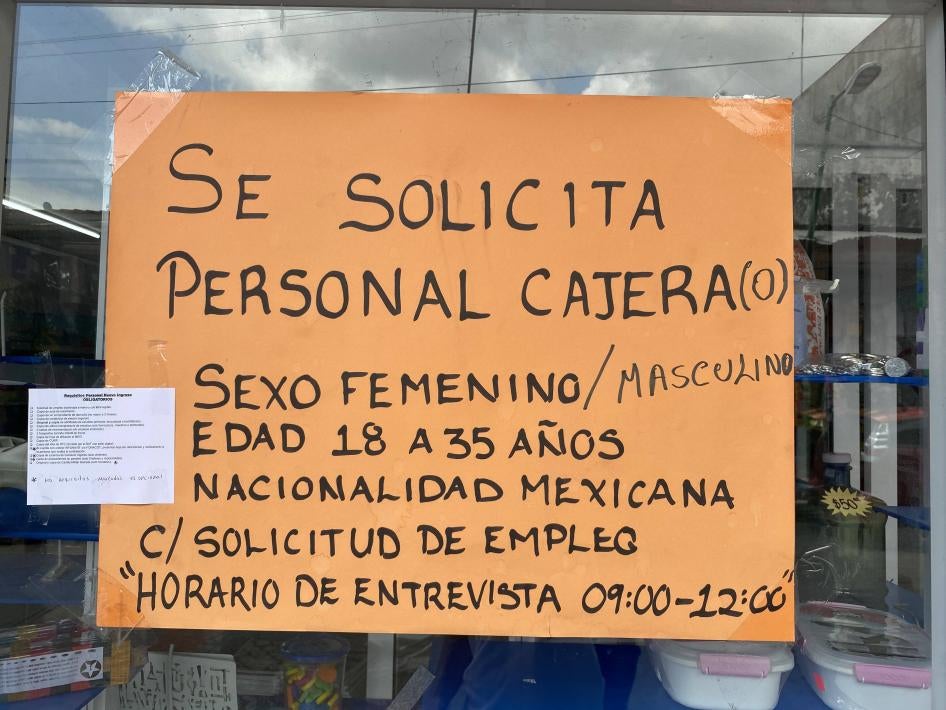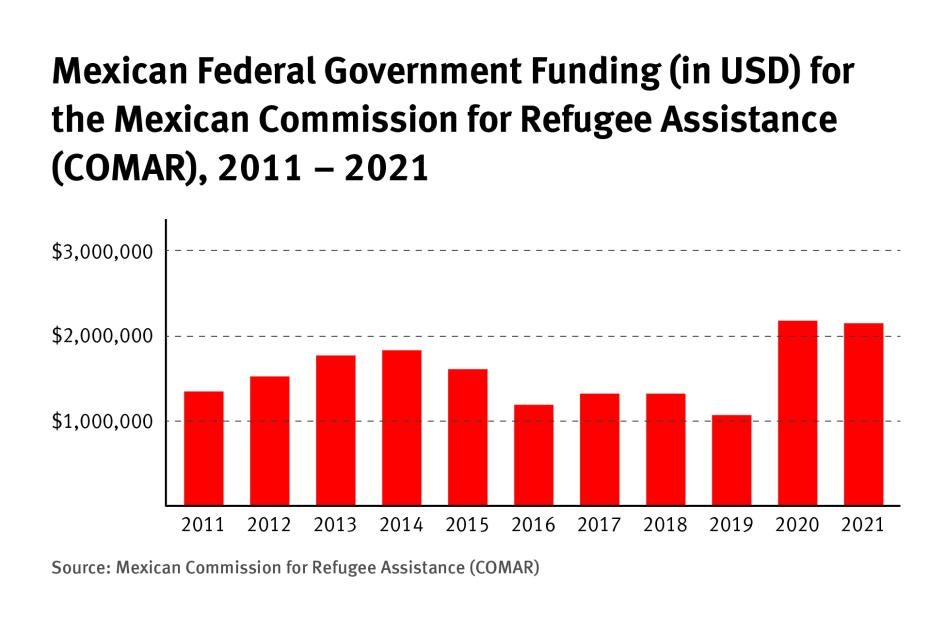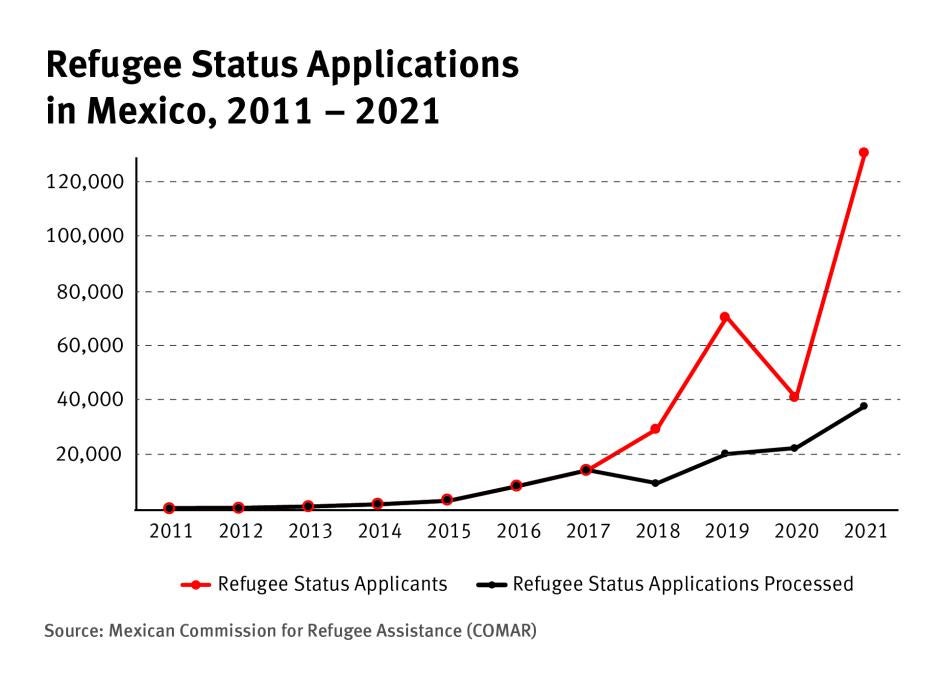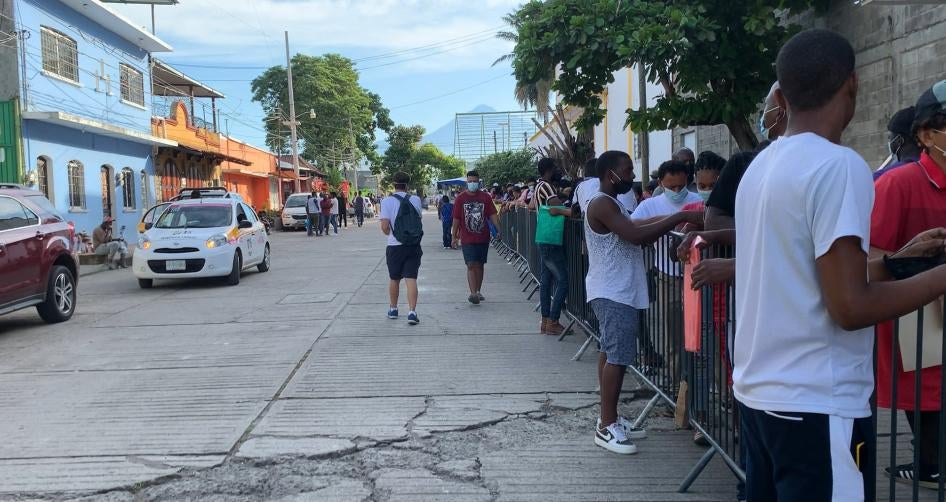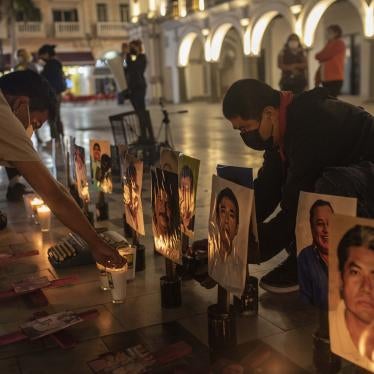(Los Angeles) – Migrants and asylum seekers who enter Mexico through its southern border face abuses and struggle to obtain protection or legal status as a result of policies aimed at preventing them from reaching the US, Human Rights Watch said today. As leaders meet in Los Angeles for the Summit of the Americas, they should commit to ending abusive anti-immigration policies and to ensuring people seeking protection are received humanely in the US, Mexico, and elsewhere.
Refugee status applications and migrant apprehensions in Mexico have risen dramatically as US President Joe Biden has continued restricting access to asylum at the US southern border, and pushed Mexican President Andrés Manuel López Obrador to heavily regulate travel to and within Mexico in order to prevent non-Mexican migrants from reaching the US. Those who cross Mexico’s southern border fleeing violence and persecution struggle to obtain protection, face serious abuses and delays, and are often forced to wait for months in inhumane conditions near Mexico’s southern border while struggling to find work or housing.
“Outsourcing US immigration enforcement to Mexico has led to serious abuses and forced hundreds of thousands to wait in appalling conditions to seek protection,” said Tyler Mattiace, Americas researcher at Human Rights Watch. “The Summit of the Americas is an opportunity for regional leaders, including presidents Biden and López Obrador, to commit to a regional migration agreement that moves away from heavy-handed enforcement policies and towards protection and human rights.”
Leaders from the Western Hemisphere are expected to sign a regional declaration on migration and protection during the Summit of the Americas, hosted by President Biden in Los Angeles. Any agreement signed should include commitments by leaders to restore and expand access to protection across the continent, to end heavy-handed enforcement policies that have led to abuses.
Mexico apprehended 307,569 migrants in 2021, the highest number ever recorded. A record 130,863 people also applied for refugee status in Mexico in 2021, the third-highest number in the world according to the United Nations refugee agency UNHCR. A decade ago, just a few thousand applied per year.
Most of those entering the southern border are Black, brown, and Indigenous people from Central America and the Caribbean who lack visas to enter Mexico. Nearly half of all asylum applicants in Mexico in 2021 were Haitians. Most enter near the city of Tapachula, in Chiapas state. Around 70 percent of those who apply for refugee status in Mexico do so in Tapachula.
Human Rights Watch interviewed more than 100 migrants, asylum seekers, representatives of migrants’ rights groups and UN agencies, and officials from Guatemala, Honduras, and Mexico, between August 2021 and April 2022, in person and by phone, in Tapachula and Mexico City, and in Tecun Uman, Guatemala, near the main border crossing.
Video, Israel, 24, Nicaragua
Most asylum seekers enter Mexico undocumented. Most said they came fleeing violence or persecution in their home countries but did not attempt to request protection at an official border crossing, fearing agents from Mexico’s immigration authority, the National Migration Institute (INM) would deport them. Most applied for refugee status once in Mexico. A few said they sought protection at the border and were turned away by INM agents or security guards. Many said INM agents dissuaded them from seeking refugee status in Mexico and pressured them to accept voluntary returns to their countries.
“I thought they would help us when we got to Mexico, but when we came to the border bridge and asked for protection they turned us away,” said one man who fled forced gang recruitment in Honduras. “I never thought I would have to leave my country. Now, I know if I went back, I wouldn’t last very long alive. If you don’t obey the gangs there, they force you to – or they kill you.”
In 2021, nearly 90,000 people applied for refugee status in Tapachula, equivalent to a quarter of the city’s population. Most wait many months for their applications to be reviewed and to receive documents proving their legal status and allowing them to leave. They often face discrimination, and struggle to find work and housing. Support programs by UNHCR and the Mexican government are insufficient. Some interviewees said they felt unsafe in Tapachula because it is close to the Guatemalan border, where the criminal groups they had fled were operating.
Mexico’s refugee system has been overwhelmed by the enormous growth in applicants. The budget for the refugee authority, the Mexican Commission for Refugee Assistance (COMAR), which is separate from the INM, has not kept pace, and it has a growing backlog of refugee status applications. In 2021, it received more than 130,000 but only processed 38,005. UNHCR pays for many basic operating costs, including two-thirds of staff’s salaries. UNHCR contributed $4.5 million in 2021. The federal government contributed just over $2 million. State governments provide free space for some offices and refugee centers.
Most asylum seekers said they were fleeing death threats, extortion, and forced recruitment by gangs or drug cartels in Honduras, Guatemala, or El Salvador – or political persecution and generalized human rights abuses in Cuba, Nicaragua, and Venezuela.
Senior INM officials said they do not believe most people seeking refugee status in Mexico have legitimate claims, either because they do not believe they are truly fleeing violence and persecution or because they believe most would prefer to seek asylum in the US. Mexican Foreign Relations Secretary Marcelo Ebrard has expressed similar sentiments publicly.
COMAR is able to review only some of the refugee status applications it receives. It grants protection to nearly all Hondurans, Salvadorans, and Venezuelans whose cases it reviews. But it rejects most applicants from Haiti, saying they do not qualify as refugees. COMAR officials have acknowledged that Haitians cannot be safely returned due to the severe security crisis there. The INM issued temporary “humanitarian” visas to about 50,000 Haitians in 2021. In 2022 it began a pilot program to allow 200 Haitian families who do not qualify as refugees to apply for residency in Mexico.
US President Joe Biden has continued many of former president Donald Trump’s abusive anti-immigration policies, including pressuring Mexico to stop migrants from reaching the US and blocking access to asylum at the US southern border through policies like Title 42 and Remain in Mexico. President Andrés Manuel López Obrador has deployed almost 30,000 soldiers alongside National Migration Institute (INM) agents to apprehend undocumented migrants throughout Mexico.
Both the Biden and López Obrador administrations have a role in improving access to asylum procedures and the processing of refugee status applications in Mexico, Human Rights Watch said. The US should restore access to asylum at its border and stop pressuring Mexico to crack down on migration. Mexico should ensure that COMAR is properly funded and that asylum seekers are able to make claims at border crossings and from detention centers. Mexico should streamline processing of residence visas for those who have been recognized as refugees. And it should ensure that Haitians have access to protection and legal status.
“President López Obrador has often portrayed Mexico as a champion of migrants and asylum seekers,” Mattiace said. “If that is true, he should demonstrate it by ensuring asylum seekers in southern Mexico get a humane welcome.”
For additional information on the findings, recommendations, and a selection of cases, please see below. Unless noted otherwise, the cases are based on the direct testimony of interviewees.
Human Rights Watch interviewed 80 migrants and asylum seekers in Tecun Uman, Guatemala, and Tapachula, Mexico, primarily in August and September 2021, with additional interviews conducted into May 2022, with 28 representatives of UN bodies, the Mexican, Guatemalan, and Honduran governments, the Chiapas state prosecutor’s office, and migrants’ rights organizations. Human Rights Watch also reviewed documents, photos, videos, text messages, and voice notes that supported and often directly corroborated individual case accounts and received information from the Mexican federal and the Chiapas state government.
The findings are consistent with previous Human Rights Watch work, conducted in 2015 and 2020, which found that the immigration agency pressured migrants not to claim refugee status or to abandon claims and illegally expelled some, including children, who feared for their lives in their home countries.
Stepped Up Immigration Enforcement
President López Obrador has intensified immigration restrictions and enforcement efforts in response to US pressure. He imposed new visa requirements, making it harder for Brazilians, Venezuelans, and Ecuadorians to travel to Mexico. He has also imposed new restrictions on domestic travel, including requiring proof of immigration status for domestic bus trips and regular immigration status checks on domestic flights.
The INM has a significant presence across Mexico and operates one of the largest immigration detention systems in the world, with over 6,000 staff in 499 locations, including 194 points of entry and 66 immigration detention centers. Soldiers and immigration agents conduct “control and verification” operations nationwide to apprehend undocumented migrants. They operate checkpoints on major roads and conduct patrols and surprise inspections on buses and airplanes, at hotels, along the northern and southern borders, and in public spaces like parks. They regularly publicize these efforts. The Mexican Supreme Court recently ruled these checkpoints unconstitutional. Congress will need to amend the law for the ruling to take effect.
In some cases, efforts to apprehend undocumented migrants have led to serious violence and even deaths. In October 2021, National Guard troops opened fire on a truck carrying migrants, in an apparent attempt to detain them, killing two. According to news reports, survivors alleged that the troops tried to cover up the killings by planting a weapon on one of the victims and claiming they had shot in self defense. This is a common and well-documented practice by soldiers. In March 2021, soldiers shot and killed a Guatemalan man who failed to stop at a checkpoint. In September, immigration agents were filmed kicking and beating families in a migrant caravan.
Mexico’s Refugee System
Under Mexican and international law, anyone has the right to apply for refugee status and have their claim heard by appropriate authorities. Officials are prohibited from returning people to a country where their life would be threatened or they would be at risk of torture or cruel, inhuman, or degrading treatment, regardless of whether they intend to apply for refugee status in Mexico.Mexico’s refugee system is overseen by COMAR, a much smaller agency than the INM, which oversees all other immigration issues, including enforcement. COMAR receives and decides refugee status claims at its nine offices throughout the country. It has no permanent presence at airports or border crossings.
Mexican law recognizes anyone fleeing generalized violence, internal conflict, or massive human rights abuses that seriously disturb public order, among others, as a refugee. COMAR has determined that Salvadorans, Hondurans, and Venezuelans come from countries where these conditions are prevalent. As long as their reason for fleeing is connected to the disturbance of public order, COMAR nearly always presumes they are refugees and grants them protection.
But applicants from other countries where Human Rights Watch has documented similarly dangerous conditions, such as Cubans and Haitians, are not given this treatment, and are much less likely to receive protection. COMAR officials say most Haitians do not qualify as refugees, since many previously had legal status in Chile or Brazil and do not cite disturbed public order as a reason for leaving Haiti.
COMAR can also grant a legal status called “complementary protection” to anyone who does not qualify as a refugee but cannot be safely returned to a home country. COMAR officials have acknowledged Haitians cannot be safely returned, but COMAR rarely grants complementary protection to any applicants, including Haitians.
COMAR provides applicants a certificate confirming their status as a refugee status applicant. They can use it to apply to the INM for a temporary “humanitarian” visa, valid until their claim is resolved, which they can show to avoid being detained if stopped by INM agents. COMAR also provides applicants a temporary national ID number, needed to work and access services.
Applicants are not allowed to leave the state while their application is pending, even if they have a “humanitarian” visa. Those found to have done so by immigration agents are considered to have “abandoned” their application and can be detained and deported.
Once someone is recognized as a refugee, their temporary “humanitarian” visa is no longer valid. They must apply to the INM for a permanent residence visa. Without it, they cannot travel within Mexico and may be detained and considered undocumented if they reach a checkpoint. Recognized refugees are exempt from visa application fees.
Barriers to Protection for Detained Migrants
Human Rights Watch interviewed 19 people who had been held in immigration detention centers. Most said they were detained after entering the country undocumented, before applying for asylum.
Some said immigration agents tried to dissuade them from applying for refugee status and pressured them to agree to voluntary return, even when they said they would be at risk of violence and persecution in their home countries. Some said they were instructed to sign voluntary return documents without reading them. Others said agents used poor conditions in detention as a deterrent, saying they would spend months in detention if they sought refugee status.
Immigration officials said that their agents always inform detained migrants of their right to seek refugee status. However, COMAR rarely receives refugee status claims from apprehended migrants, according to official statistics. Of the over 130,000 refugee status applications received by COMAR in 2021, only 4,177, about 3 percent, came from people apprehended by the immigration agents at the border.
All asylum seekers are identified by pseudonyms for their protection. The following are some of their accounts:
They detained me on Friday. On Monday, the immigration agent arrived. She took us up to the second floor. She told us “You have two options here: deportation or COMAR. The best thing for you to do is request voluntary deportation, because if you request COMAR you could be here from 90 days to three years waiting for a decision. And apart from that you need to wait for your visa. You’re going to waste a lot of time that way. Why don’t you just go back to your countries? -Emiliano, 51, Venezuela
Video, Emiliano, 51, Venezuela
The day after I was detained, the immigration agent came and said we all had to sign our deportation papers. I told him “I don’t want to be deported. I want asylum.” He asked me my name. Then he turned to the group and said “Julio is talking about asylum. You should all know that if you request asylum, you will be here for six months.” The others said they didn’t want to be in detention for six months, so they signed the papers and were sent back. I was the only one who refused to sign. -Julio, 29, Honduras
They never said to me “Do you want COMAR? Do you want to request COMAR or do you want deportation?” They didn’t say anything to me. I didn’t know anything about that. And they brought me to talk to the consul. They asked for my personal information, my age. And then, two days after talking with the consul, they came with my deportation papers, and they didn't let me read anything. They said: “sign quickly, fingerprint quickly,” and you couldn’t read what you were going to sign. -Juana, 21, Honduras
Video, Juana, 21, Honduras
When you enter that place, you lose your human rights. I asked a guard if I could have my phone back to tell my family where I was. He told me “No one here gets to talk with their family.” There were so many of us, we slept one on top of the other. We were even sleeping on the bathroom floor – like a prison. Lots of us had fever, flu, or a cough. They didn’t give you any medicine. I was coughing, but they told me “You’re not dying yet. Come back when you’re dying.” Half of us had Covid-19 symptoms. I was afraid I would die. -Emiliano, 51, Venezuela
Difficulties Accessing Protection at the Border
Migrants and asylum seekers should be able to request protection from immigration agents at border crossings or after entering Mexico, under Mexican and international law. The agents are legally prohibited from turning away anyone with a refugee status claim or anyone whose life would be at risk upon return to their home country. They are required to allow them into Mexico and to forward their requests to COMAR.
But most enter Mexico irregularly, even those intending to seek refugee status. Nearly every interviewee said they had entered Mexico irregularly, taking a raft or wading across the Suchiate River, which separates Mexico and Guatemala. They had not gone through an official border crossing, fearing immigration agents would detain and deport them when they attempted to enter the country or request protection, they said.
Video, Israel, 24, Nicaragua
Immigration officials said asylum seekers rarely enter at official crossings, but if they do, the policy is to take adults into custody and transfer them to an immigration detention center – and to transfer children and families to a shelter – where they wait to speak to a COMAR representative and make a refugee status claim.
But the interviews suggest the situation is more complicated. Experiences varied, suggesting immigration agents and private security guards on the Rodolfo Robles border bridge, connecting Tecún Uman, Guatemala and Ciudad Hidalgo, Mexico, at times decide on their own how to respond. Human Rights Watch also spoke to the Human Rights Monitoring and Observation Collective for Southwest Mexico (COMDHSM), a collective of migrants’ rights groups that helped some of the migrants.
COMDHSM said they helped 87 asylum seekers enter legally between February and June 2021. They stopped doing so, they said, after receiving phone calls from an immigration official who threatened them with a criminal investigation on human trafficking charges. Immigration agents often harassed the COMDHSM staff at the border, they said, attempting to prevent them from entering the immigration office or speaking to asylum seekers.
Once, as they accompanied a family of asylum seekers, National Guard troops and two Suchiate municipal police officers arrived, threatening to detain them, they said. They reported the incident to the National Human Rights Commission, which urged the immigration agency to ensure their safety. The agency later sent the groups a letter saying it had instructed staff at the border to follow its code of conduct.
Nine people interviewed said that they or their families attempted to enter the country by telling agents on the Rodolfo Robles border bridge that they wished to seek refugee status in Mexico.
Video, Francisco, 28, Honduras
Video, Ximena, 31, Honduras
My husband was in jail for 12 years, from age 14 to 26. In jail, you have to join a gang if you want to survive. He didn’t want to do it, but they made him. A few years before he was released, he told the gang he was going to quit. That night, someone broke into his mother’s house and shot her. We knew that as soon as he got out of jail it could happen to us too. The Red Cross told us we could go to Tecún Uman and request asylum in Mexico. The whole family went – seven of us. On the bridge, the Mexican immigration agents made us wait for hours. Finally, they said only the two children and one adult could enter. The rest of our family would have to stay in Guatemala. We said “it’s all of us or no one.” In Guatemala, they gave us the contact of a Mexican organization. The next week, they met us at the bridge and talked with the immigration agents, who finally let us cross. -Ana, 30, Guatemala
When we got to Tecun Uman, people told us: to avoid problems on the bridge, just cross on a raft. But I don’t do things like that. Take a raft across the river with my two kids? Cross a border illegally? No. We’re supposed to rely on the authorities to protect us. We went to the bridge. But they kept telling me to leave. They wouldn’t look at my papers until someone from the human rights group came and helped us. -Ximena, 31 Honduras
Forced to Wait in Poor Conditions in Tapachula
People applying for refugee status can wait for months in Tapachula – a month or more for the initial COMAR appointment; then from a month to more than a year for review, depending on the complexity of the case; and, upon approval, three to six months for an appointment for a residence visa. Without a visa, they are usually not allowed to travel. The immigration agency operates checkpoints throughout Chiapas, including on roads leading out of town and throughout the state, and at bus stations and airports.
While neither government officials nor migrants’ rights groups know how many migrants are waiting in Tapachula, a city of just over 350,000, the 90,000 refugee status applications made there in 2021 suggest the number is high. Interviewees said that living conditions in shelters are often abysmal, jobs are difficult or impossible to get, they have difficulty obtaining medicine, and many receive little or no support while they wait.
Video, Israel, 24, Nicaragua
Video, Ximena, 31, Honduras
The Danish Refugee Council conducts regular surveys of migrants in Tapachula, asking about access to work, housing, and services. Seventy-five percent of the 438 families they surveyed for their January 2022 report said nobody in their family had worked in the past three months. Eighty-one percent said their children were not enrolled in schools, as they did not intend to stay in Tapachula. Around half said they could not afford to buy medicines and 40 percent said they did not know how to access medical treatment. About 70 percent said they did not have a national ID number, which is required to be seen at public hospitals.
The Chiapas secretary of education confirmed that just over 1,000 non-North American students were enrolled in Tapachula public schools in the 2020-2021 school year. The secretary of health keeps no record of the nationality of patients at public clinics.
Financial support programs provided by UNHCR and the government for refugee status applicants fail to reach many who need help. UNHCR short-term cash assistance for vulnerable people, of US $100-300 per month for up to three months, reaches about 100 households each week. In a federal welfare program for refugee status applicants, most of the approximately 1,500 participants a week plant trees or do farm work, officials said. They receive US $130 every two weeks. Human Rights Watch saw hundreds of people lined up every morning seeking to enroll in both programs.
I can’t leave Tapachula. I have to stay here. With regards to work, it’s difficult. People don’t feel comfortable giving work to a foreigner, and it has been really hard being in a country that is not yours. I’ve gone through lots of situations that I’ve never had to deal with before. Like being on the street without a single cent. Not having anything to eat. Not having anything to drink. It’s really hard. -Israel, 24, Nicaragua
We left Honduras because a drug cartel kicked us off our farm. But here, in the shelter, a woman came up to me and said her family is with the same cartel. She knew about us. She threatened us. I just want to leave Chiapas and be somewhere safer. – Carla, 27, Honduras
Some said landlords and employers refuse to rent to or hire non-Mexicans. Signs posted outside some businesses advertised jobs for Mexicans only.
It’s hard to find someplace to live here. The shelters are awful; I don’t feel safe there with my children. I recently found an apartment. The landlord told me the building doesn’t allow foreigners; it’s written in the lease. He told me if the neighbors hear my accent or figure out I’m Honduran, he’ll evict me. -Ximena, 31, Honduras
I was a taxi driver in Honduras. MS-13 came and demanded a “tax.” I ignored it. Then they came to my house. They said if I didn’t pay they would kill us. But they wanted more money than I earned; I had no way to pay. I have some friends in Monterrey [in northern Mexico], so we wanted to go there. But right now we can’t leave Tapachula. When we got here, we didn’t know what to do. At first, we slept in the park, me, my wife, and my two kids. Then, we found a shelter. They say we have to wait here for months. But I can’t get work here. I don’t know what we’ll do. -Joel, 20, Honduras
Difficulties Leaving Tapachula
Most people interviewed said they were desperate to leave Tapachula, either because they felt unsafe or could not find housing or work. Some said they had family or friends in other parts of Mexico who could help. Officials and migrants’ rights groups confirmed that as a common complaint.
COMAR allows refugee status applicants to transfer their case to an office in another state, but officials said they only approve requests in exceptional cases, such as when applicants demonstrate they are being threatened or are otherwise in danger in Tapachula.
As waiting time for humanitarian visas and residence visas has grown, those waiting in Tapachula have begun to protest delays and difficulties. They have organized hunger strikes, sewn their mouths shut, burned tires, attacked immigration offices, and clashed with soldiers and police. They have organized frequent pedestrian “caravans,” trying to pass checkpoints. In some cases, immigration agents and the National Guard have violently broken up caravans.
The INM response has been disorganized and opaque, and Tapachula migrants’ rights groups say it has caused “confusion and tension.” In November and December, when large numbers of Haitian asylum seekers were waiting in Tapachula, the agency circulated messages on social media encouraging those who wished to leave to come to the city’s football stadium for the opportunity to transfer to another state. Tens of thousands came.
Conditions in the stadium were crowded, disorganized, and unsanitary, with people waiting in the sun and sleeping on the ground, no garbage facilities or drinking water, and dirty, overused toilets, said Refugees International, which visited in December. Soldiers patrolled the stadium. The INM said it transferred 42,000 people to other states in December, mostly Haitians.
Since then, the agency has expedited humanitarian visas or provided transfers for those who protest or form caravans, seemingly to avoid the unwanted international media attention that these often draw. Others continue to wait months for appointments in Tapachula. As of April, the INM said it had transferred more than 50,000 people since November 2021 to 24 states.
In May, the INM told us it had more than doubled its capacity in Chiapas in an effort to reduce wait times and could now receive 1,110 applications per day, up from 468.
UNHCR operates an integration program that relocates recognized refugees from southern Mexico to 10 cities in central and northern Mexico and helps them find housing and work. The program has relocated over 18,000 since it began in 2016.
The International Organization for Migration began a pilot program in 2022 to help families in Tapachula who do not qualify as refugees obtain legal status, relocate to central Mexico, and find work and housing there. It had relocated 60 families as of May and plans to relocate 200 by the end of 2022.
Overwhelmed Refugee System
Refugee status applications in Mexico have soared as the US has restricted access to asylum and Mexico has stepped up immigration enforcement, making it harder to reach the US. Many interviewees said they had left home hoping to reach the US but, upon realizing the challenges, would accept staying in Mexico.
COMAR funding has not kept pace. While refugee status applications increased 174-fold over the past decade, government funding for COMAR increased just 2.5-fold, to 44 million pesos (US $2.2 million) in 2021.
|
Year |
Refugee Status Applicants |
COMAR Funding (USD) |
|
2011 |
752 |
$1,369,899 |
|
2012 |
811 |
$1,551,517 |
|
2013 |
1,296 |
$1,805,209 |
|
2014 |
2,137 |
$1,866,070 |
|
2015 |
3,423 |
$1,637,955 |
|
2016 |
8,796 |
$1,207,568 |
|
2017 |
14,619 |
$1,346,249 |
|
2018 |
29,574 |
$1,343,380 |
|
2019 |
70,327 |
$1,083,855 |
|
2020 |
40,962 |
$2,221,224 |
|
2021 |
130,863 |
$2,190,278 |
COMAR officials said existing funding is insufficient even for basic operational expenses; they rely heavily on outside support. UNHCR provided US $4.5 million in 2021, twice as much as the Mexican government. UNHCR pays for the buildings COMAR uses in some cities and covers office supplies like paper and printer ink. Until recently, UNHCR employed 230 of COMAR’s 361 staff through an outsourcing agency. This caused problems since outsourced staff cannot perform some basic tasks like signing official documents.
Video, Andrés Ramírez, COMAR
In April, UNHCR began transferring money to enable COMAR to directly employ most staff, although 12 were still outsourced as of May. COMAR has also received support from the Coahuila, Jalisco, and Chiapas state governments, which have provided buildings and land for offices and processing centers.
Despite this support, COMAR is struggling to process the growing number of applications in a timely manner. A backlog of unresolved cases means asylum seekers can face waits of more than two years. In 2021, COMAR received applications from 130,863 people and resolved or closed just 38,000.
About 70 percent of refugee status claims are made through the COMAR office in Tapachula, where officials have struggled to manage demand for appointments. To receive an appointment, usually in a month, crowds of asylum seekers form a line outside the office early in the morning. Some spend the night in line.
In August 2021, COMAR created an online appointment system. Within a few weeks, appointments were booked until the end of the year. Media reported that people were selling appointments for the equivalent of hundreds of dollars. In September, COMAR took the system offline and announced that it would temporarily receive applications in Tapachula’s football stadium. As of April, officials said they were back to assigning appointments at the office.
Recommendations
To the INM
- Ensure that immigration agents inform all apprehended migrants of their right to seek refugee status or other forms of international protection in Mexico, as required by national law, and do not attempt to dissuade people from seeking protection.
- Improve conditions of migration detention, particularly by ensuring:
- adequate, clean, and safe sanitation facilities;
- proper and clean bedding for each detainee;
- access to telephones; and
- timely, proper responses to requests for medical care.
- Expedite procedures to apply for residence visas for recognized refugees.
- Make it simpler and less costly for those already eligible for legal status in Mexico to apply for and receive it without applying for refugee status.
- Work with the International Organization for Migration to expand the pilot program to help non-refugees obtain legal status and integrate in cities in Central Mexico.
To COMAR
- Place representatives at border crossings and points of entry to facilitate protection for those requiring it.
- Expand presence at detention centers to ensure that detained asylum seekers can seek refugee status.
- Evaluate claims from Haitians using the same standard applied to other applicants from countries experiencing generalized violence, or mass human rights violations that have seriously disturbed public order.
- Grant complementary protection to Haitians who do not qualify as refugees and do not have legal status in another country, since they cannot be safely returned to Haiti.
To the Mexican Interior Ministry
- Conduct an audit of COMAR’s needs and capacity, and ensure that the agency is sufficiently staffed and funded.
To the Biden Administration
- Restore access to asylum at the US border.
- Stop pushing Mexico to prevent migrants from reaching the US border, and collaborate with Mexico and other governments to create a holistic regional plan for access to protection and safe, dignified migration.
- Provide support for COMAR to permanently expand its capacity.
